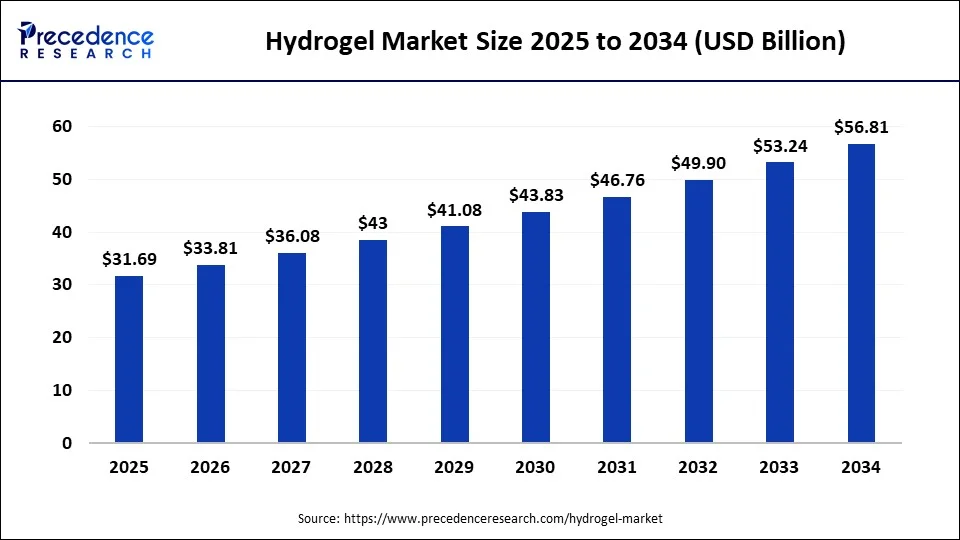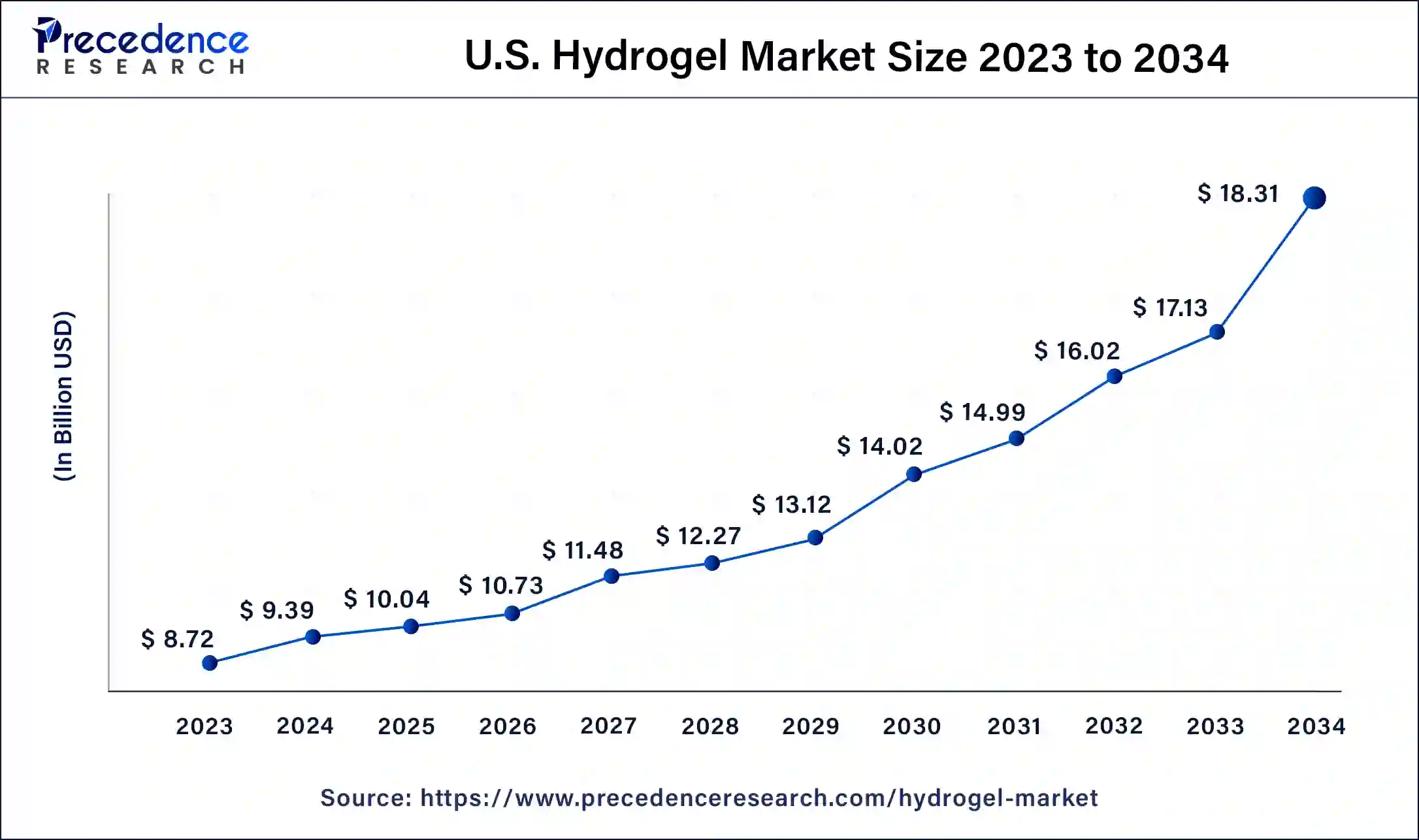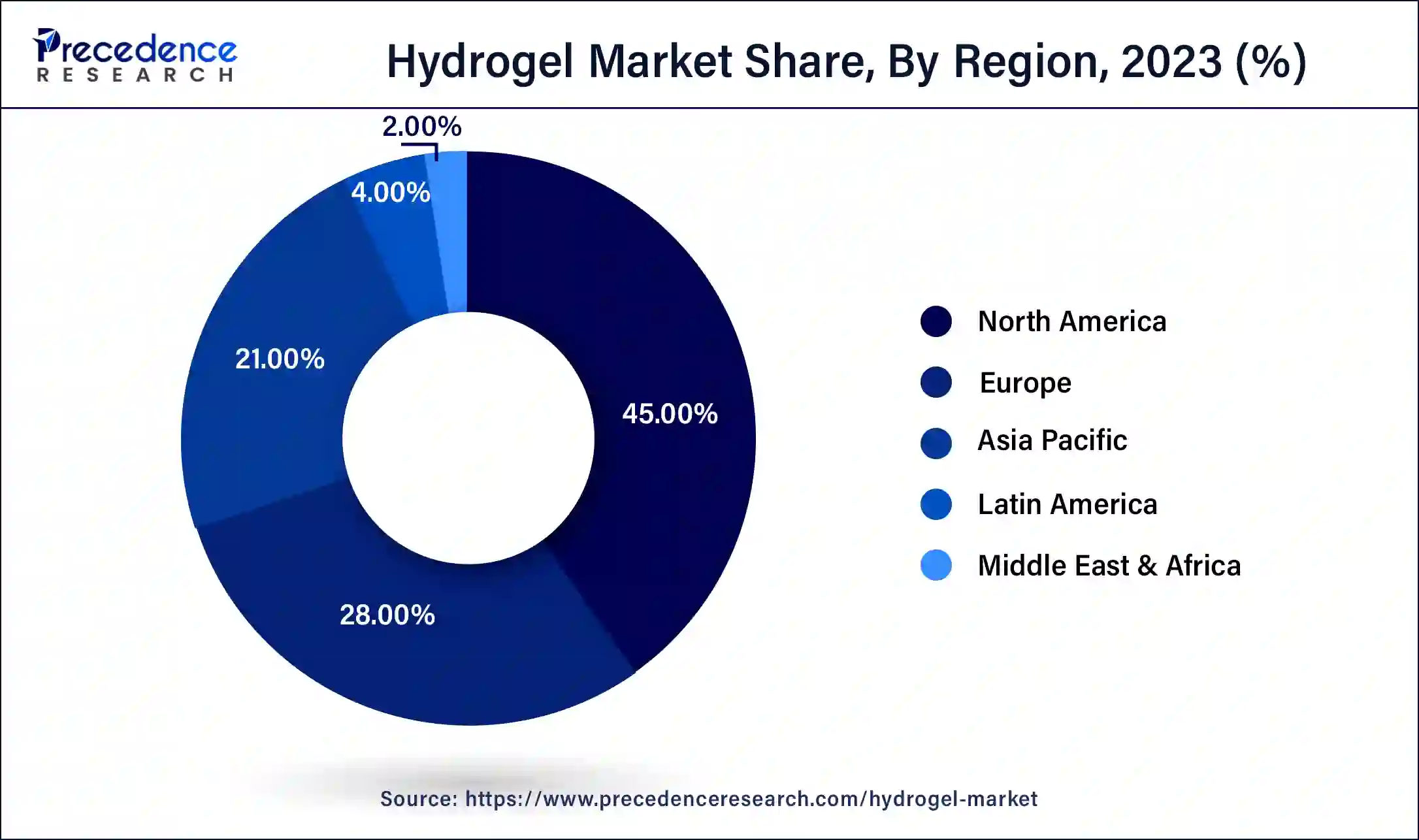List of Contents
Hydrogel Market Size and Forecast 2025 to 2034
The global hydrogel market size accounted for USD 29.70 billion in 2024 and is predicted to reach around USD 56.81 billion by 2034, expanding at a CAGR of 6.7% from 2025 to 2034. The North America hydrogel market size reached USD 12.43 billion in 2023.

Hydrogel Market Key Takeaways
- In terms of revenue, the market is valued at $31.69 billion in 2025.
- It is projected to reach $56.81 billion by 2034.
- The market is expected to grow at a CAGR of 6.70% from 2025 to 2034.
- In 2023, North America market has held revenue share of 45% in 2024.
- By raw material, the synthetic segment accounted highest revenue share of 74% in 2024.
- By composition, the silicone-modified hydrogels segment has generated a market of 28% in 2024.
- By form, the semi crystalline hydrogels segment has captured a revenue share of 68% in 2024.
- By product, films & matrices have captured 37% revenue share in 2024.
U.S. Hydrogel Market Size and Growth 2025 to 2034
The U.S. hydrogel market size was estimated at USD 9.39 billion in 2024 and is predicted to be worth around USD 18.31 billion by 2034, at a CAGR of 6.90% from 2025 to 2034.

North America dominated the hydrogel market in 2024. This is attributed to the increased demand for hydrogels in biotechnology,tissue engineering,agriculture, medicine, and other fields. Due to rising demand for personal care, hygiene, and health care items such as baby diapers, sanitary pads, and paper towels in the developed countries in the North America region have seen substantial growth in the market.

Asia-Pacific, on the other hand, is expected to develop at the fastest rate during the forecast period. Due to increased per capita income and growing population, the Asia-Pacific region has experienced tremendous growth. The emerging nations of Asia-Pacific region are likely to drive the hydrogel market forward throughout the forecast period due to rising disposable income and technological advancements.
Europe is expected to grow significantly in the hydrogel market during the forecast period. The growing research and development in industries as well as institutes in Europe are enhancing the development of hydrogel. These are further supported by the government as well as regulatory bodies. Thus, this promotes the market growth.
UK Hydrogel Market Trends
The presence of well-developed industries as well as institutes in the UK is increasing the new developments in hydrogel formulations. At the same time, their use in various industries is contributing to the same. Furthermore, to make them safe and effective, support and regulations are provided by the regulatory bodies.
Germany Hydrogel Market Trends
Due to growing diseases in Germany, the demand for the use of hydrogel is increasing. These hydrogels are being used in the treatment of cancer as well as in wound healing. At the same time, to enhance its applications, research is also being conducted.
Market Overview
Hydrogel is a three-dimensional network structure composed of cross-linked water-soluble polymers that can be natural or synthetic. It has a moisture-retaining capacity and thus can absorb a large amount of water or biological fluids. Biocompatibility, porosity, flexibility, and water-holding capacity make it ideal for medical applications. Biocompatible hydrogel adapts well to living tissues, providing no external harm to the internal body or skin. It allows clinicians to pursue biodegradable solutions for the medical interventions of drugs in the patient's body as the hydrogels used get degraded enzymatically. Hydrogel dressings are ideal for wound healing and can absorb the fluids coming out through the wounds due to their water-holding capacity.
Hydrogel finds application in the agriculture, biomedical, food, and cosmetics industry. It is widely used in medical devices, personal care products, and water treatment. In tissue engineering, it is used to regenerate tissues. The researchers can perform diverse cell culturing projects inside the laboratories.
- In October 2023, Kuraray Co. Ltd. developed hydrogel microcarriers for cell culturing in regenerative medicine.
Major Market Breakthroughs
In May 2025, a hydrogel using ultrasound was developed by the collaboration between researchers of McGill University and Polytechnique Montréal, which in turn can eliminate the need for toxic chemical initiators. Thus, to develop hydrogels that are resistant to dehydration and freezing, at the same time are stronger and flexible, this approach can provide a cleaner, more sustainable, and faster approach in hydrogel production and fabrication.
In January 2025, for targeted treatment of breast cancer, an advanced injectable hydrogel was recently developed by the collaboration between the researchers of the Indian Institute of Technology (IIT) Guwahati and Bose Institute, Kolkata. It can be used instead of conventional cancer treatments such as chemotherapy, which has harmful side effects, and surgery, which cannot be conducted for cancer in internal organs. Thus, this hydrogel-based therapy helps in minimizing these side effects as the anti-cancer drugs provide targeted action. Source: Ultrasound unlocks a safer, greener way to make hydrogels Indian scientists develop injectable hydrogel for targeted breast cancer treatment - IBTimes India
Hydrogel Market Growth Factors
- The hydrogels are a type of polymer with a hydrophilic structure that allows them to hold huge amounts of water in three dimensional networks. The widespread use of these products in a variety of environmental and industrial settings is seen as crucial. The natural hydrogels were gradually phased out in favor of synthetic hydrogels, which have a better water absorption capacity, a longer service life, and a wider range of chemical raw materials. The polyethylene glycol hydrogels are commonly employed in a variety of biomedical applications, including biomolecular release matrices and regenerative medicine structures.
- The hydrogels are employed in a variety of applications. This is due to their unique structures and compatibility with a variety of operating situations. The hydrogels' flexibility, which is due to their water content, allows them to be used in a variety of environments ranging from industrial to biological, and the biocompatibility of the materials used to make them, as well as their chemical behavior in biological environments, which can be low in toxicity, broadens their applications to include medical sciences.
- In comparison to synthetic hydrogels, the edible polymer hydrogels have a number of desirable features. The hydrogel helps to improve recyclability, reduce pollution, and ensure long term viability. The biomedical applications, food industry, pharmaceutical, medication delivery, and environmental domains are some of the fields where edible polymer-based hydrogels are used on a large scale. During the projected period, the global hydrogel market will be driven by innovations and expanding uses of hydrogel.
During the projection period, the global hydrogel market is likely to see profitable prospects as a result of variables such as hydrogel's capacity to minimize environmental contamination and provide sustainability. During the projection period, the global hydrogel market will be fueled by wide applicability of hydrogels in different industries. Furthermore, the hydrogel is employed in the pharmaceutical business to extend the shelf life of drugs. The evaporative cooling hydrogel packaging, which improves the physical stability of existing medicinal goods, is becoming more common in the pharmaceutical business. This is one of the main drivers of the global hydrogel market.
The hydrogel is also employed in the curing and treatment process. In usual healing processes, a wound dressing comprised of hydrogel gives moisture to the wound and aids in the repair of the epidermis, removal of extra dead tissue, and proliferation. Moreover, greater awareness of hydrogel formulations has prompted product focused research and development companies to develop new hydrogel products, and applications are projected to drive the global hydrogel market growth during the forecast period. The demand for hydrogels is expected to rise due to rising demand for ecofriendly goods to address issues such as environmental issues, sustainability, and biodegradability.
Market Scope
| Report Coverage | Details |
| Market Size in 2025 | USD 31.69 Billion |
| Market Size in 2024 | USD 29.70 Billion |
| Market Size by 2034 | USD 56.81 Billion |
| Growth Rate from 2025 to 2034 | CAGR of 6.7% |
| Largest Market | North America |
| Fastest Growing Market | Asia Pacific |
| Base Year | 2024 |
| Forecast Period | 2025 to 2034 |
| Segments Covered | Raw Material, Form, Product, Region |
| Regions Covered | North America, Asia Pacific, Europe, Latin America, Middle East and Africa |
Market Dynamics
Drivers
Increasing Adoption of Biomaterials
The expansion of the hydrogel market is mainly due to the increasing use of biomaterials as controlled drug delivery systems to safely administer the respective drugs for medical treatment purposes. This targeted release of therapeutic agents inside the patient's body improves the drug efficacy and reduces side effects. Drug delivery systems, such as biologically active agents, carriers, polymers, and polymer-drug formulations, are useful in ensuring focused clinical trials and success.
Another significant driver is the use of hydrogels in tissue engineering technology that aims to discover living tissues, cells, or organs with improved functionality and repair damaged ones. Different types of wound dressings, such as pH, temperature, pressure, and glucose-sensitive, can effectively monitor the wound and suggest precise treatments. The rise in the aging population and chronic diseases that require regular attention and efficiency in treatments are also boosting the need for hydrogel products. The agriculture and horticulture sectors demand the supply of hydrogels to optimize their traditional farming methods with better crop yield, soil retention, and nutrient delivery to the crops.
- Scientists at Jawaharlal Nehru Centre for Advanced Scientific Research (JNCASR) developed a silk fibroin-based hydrogel that is injectable inside diabetic patients' bodies for efficient insulin delivery. It has granted a patent for safe applications in medical fields.
- The Institute of Nano Science and Technology (INST), Mohali, developed a hydrogel that is injectable in diabetic patients' bodies to heal their wounds and skin injuries that are sensitive.
Restraint
Availability of Alternatives and High Cost
The availability of alternatives, such as synthetic polymers, can hinder the growth of the market. Moreover, the high cost associated with the production of hydrogel using high-quality materials and sophisticated manufacturing processes acts as a restraining factor.
Opportunity
3D Printing of Hydrogels
A 3D printing technology is emerging with the application of 3D printed hydrogels composed of natural and synthetic components, such as alginate, degradable polyurethane, and agarose, to offer artificial tubular structures for nerve regeneration. Bone and tissue damage caused by any infection or inflammation can be repaired with the help of 3D-printed hydrogels due to their properties of healing wounds, fighting infections, and treating tumors. 3D-printed structures of hydrogels are stronger and tougher than cartilage, with mechanical strength to retain the human body structure and maintain its 3D forms.
Raw Material Insights
The synthetic hydrogels segment dominated the hydrogel market in 2024. The synthetic hydrogels have a long service life, a high ability to absorb water, and high gel strength. The synthetic polymers, on the other hand, usually have well defined structures that may be altered to give degradability. The market for synthetic hydrogels is likely to be driven by the aforementioned factors.
The natural hydrogels segment is fastest growing segment of the hydrogel market in 2024. The hyaluronic acid, collagen, fibrin, Matrigel, and natural hydrogens including alginate, chitosan, and skill fibers are all examples of the natural hydrogels. As components of the extracellular matrix in reality, they remain the most physiological hydrogels. The natural hydrogels have wide applications in the diverse sectors.
Composition Insights
The polyacrylate segment held the largest share of the market in 2024 and is likely to expand rapidly in the near future. The ability of polyacrylate hydrogel to absorb a large amount of water makes it suitable for applications such as contact lenses, wound dressings, and diapers. Rising demand from the pharmaceutical industry is expected to contribute to segmental growth.
Form Insights
In 2024, the semi crystalline hydrogels segment dominated the hydrogel market. The hydrogel polymers that are superabsorbent are known as semi crystalline hydrogels. As a result, semi crystalline hydrogels have become popular in the wound dressing business for ulcers and surgical wounds.
The amorphous hydrogels segment, on the other hand, is predicted to develop at the quickest rate in the future years. The amorphous hydrogels are glycerin and water-based compounds that are generally used to hydrate wounds. These dressings aid in wound healing by keeping the site wet, encouraging regeneration and tissue formation, and facilitating oxidative exfoliation.
Product Insights
In 2024, the films & matrices segment dominated the hydrogel market. The hydrogel films serve as membranes or coatings in physiologically interfaced devices. The drug administration, wound healing, anti-adhesive membranes, cell culture, and soft tissue rebuilding are some of the biomedical applications for hydrogel films.
The hydrogel sheets segment, on the other hand, is predicted to develop at the quickest rate in the future years. The hydrogel sheets are prescribed for the treatment of minimally draining partial and full-thickness wounds such as deep wounds, dermal ulcers, pressure ulcers, skin tears, minor burns, infected wounds, radiation dermatitis, donor sites, and wounds with slough or necrosis, as a primary dressing product.
Hydrogel Market Companies
- Cardinal Health
- Momentive Performance Materials
- B. Braun Melsungen
- Derma Sciences
- Molnlycke Health Care
- Paul Hartmann
- Coloplast
- Johnson & Johnson
- Ocular Therapeutix
- Medline Industries
Recent Developments
- In August 2024, Johnson & Johnson collaborated with Gellycle and announced the expansion of hydrogel technology and the development of innovative hydrogel products for tissue engineering, tissue regeneration, wound healing, and to produce drug delivery systems.
- In April 2024, researchers at the Indian Institute of Science (IISc) developed environmentally sustainable hydrogels that are effective for the removal of microplastics from water.
- In January 2024, Medline Industries announced the launch of OptiView Transparent Dressing based on HydroCore Technology to help medical professionals with easy, quick, and accurate inspection and monitoring of wounds of patients. This product has better moisture retention and adhesion properties.
Segments Covered in the Report
By Raw Material Type
- Synthetic Hydrogels
- Natural Hydrogels
- Hybrid Hydrogels
By Composition
- Polyacrylate
- Polyacrylamide
- Silicone-modified Hydrogels
- Agar-based
- Others
By Form
- Amorphous Hydrogels
- Semi Crystalline Hydrogels
By Product
- Semi Crystalline Buttons
- Amorphous Gels
- Impregnated Gauze
- Films & Matrices
- Hydrogel Sheets
By End User
- Lenses
- Hygiene Products
- Wound Care
- Drug Delivery
- Tissue Engineering
- Others
By Geography
- North America
- Latin America
- Europe
- Asia-pacific
- Middle and East Africa
For inquiries regarding discounts, bulk purchases, or customization requests, please contact us at sales@precedenceresearch.com
Frequently Asked Questions
Ask For Sample
No cookie-cutter, only authentic analysis – take the 1st step to become a Precedence Research client